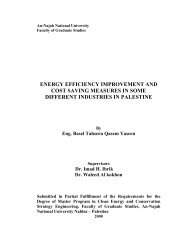THE GENUS PYTHIUM - An-Najah National University
THE GENUS PYTHIUM - An-Najah National University
THE GENUS PYTHIUM - An-Najah National University
You also want an ePaper? Increase the reach of your titles
YUMPU automatically turns print PDFs into web optimized ePapers that Google loves.
I. INTRODUCTION<br />
The genus Pythium is now regarded as the type genus of the family Pythiaceae<br />
Schroter in the order Peronosporales of the class Ooomycetes (Waterhouse,<br />
1973; Plaats-Niterink, 1981). The genus was introduced by Pringsheim (1858).<br />
His genus was based on two fungi, Pythium monospermum and P. entophytum.<br />
The latter fungus was transferred to Lagenidium (Zopf, 1890), so that P.<br />
monospermum remained as the type species. Pringsheim (1858) placed Pythium<br />
in the Saprolegniaceae, but de Bary (1881) placed the genus in the<br />
Peronosporaceae. Schroter (1897) created the family Pythiaceae for the genera<br />
Pythium and Nematosporangium. Butler (1907) did not accept Nematosporangium<br />
as representing a distinct group of species, so he included all the species under<br />
Pythium.<br />
Monographs on the genus have been published by Butler (1907), Matthews<br />
(1931), Sideris (1931, 1932), Middelton (1943), and Frezzi (1956). Waterhouse<br />
(1967, 1968) compiled the original descriptions and illustrations of all Pythium<br />
taxa described at that time; a total of )79 taxa. She produced a key for eighty<br />
nine taxa which she considered as .valid and rejected ninety taxa. This key<br />
depended heavilly on the original descriptions of the species. Since many of<br />
these were produced from the study of single isolates, without taking into<br />
consideration the possible sources or ranges of variation, original descriptions<br />
were often inadequate for comparative purposes. As a result the key frequently<br />
has to depend upon small differences in reproductive cell-size; it also emphasizes<br />
some nonmorphological characters. Robertson (1980) produced a key to the<br />
twenty seven species of Pythium recorded so far from New Zealand; illustrations<br />
and descriptions were given for sixteen species. Plaats-Niterink (1981) published<br />
the latest monograph of the genus Pythium. She recognised and described eighty<br />
five species, seven of which are heterothallic. Descriptions were again based on<br />
single isolates. Therefore, extent of intraspecific variation was not accounted for<br />
in both Robertson and Plaats-Niterink keys. However, it is difficult to assess<br />
intraspecific variation from published descriptions since the majority of these<br />
were prepared from single isolates.<br />
Pythium species occupy a wide diversity of habitats. They can be found as<br />
saprobes in fresh and salt water and in soil, and as parasites in aquatic and<br />
terrestrial plant material, fresh water and marine algae, fungi, invertebrates and<br />
vertebrates (Middleton, 1943; Plaats-Niterink, 1981).<br />
Species of Pythium have been often referred to as 'sugar fungi' (Garret, 1951;<br />
Burges, 1958), a term which infers their inability to degrade complex<br />
carbohydrate polymers, like cellulose. However, it has been recently found that<br />
several species of Pythium are capable of degrading cellulose (Taylor & Marsh,<br />
1963; Tribe, 1966; Willoughby & Redhead, 1973; Park, 1980 a,b; Deacon, 1979).<br />
It has been therefore suggested (Deacon, 1979) that the cellulolytic activity of<br />
Pythium species removes these fungi from the substrate group 'sugar fungi'.<br />
2





